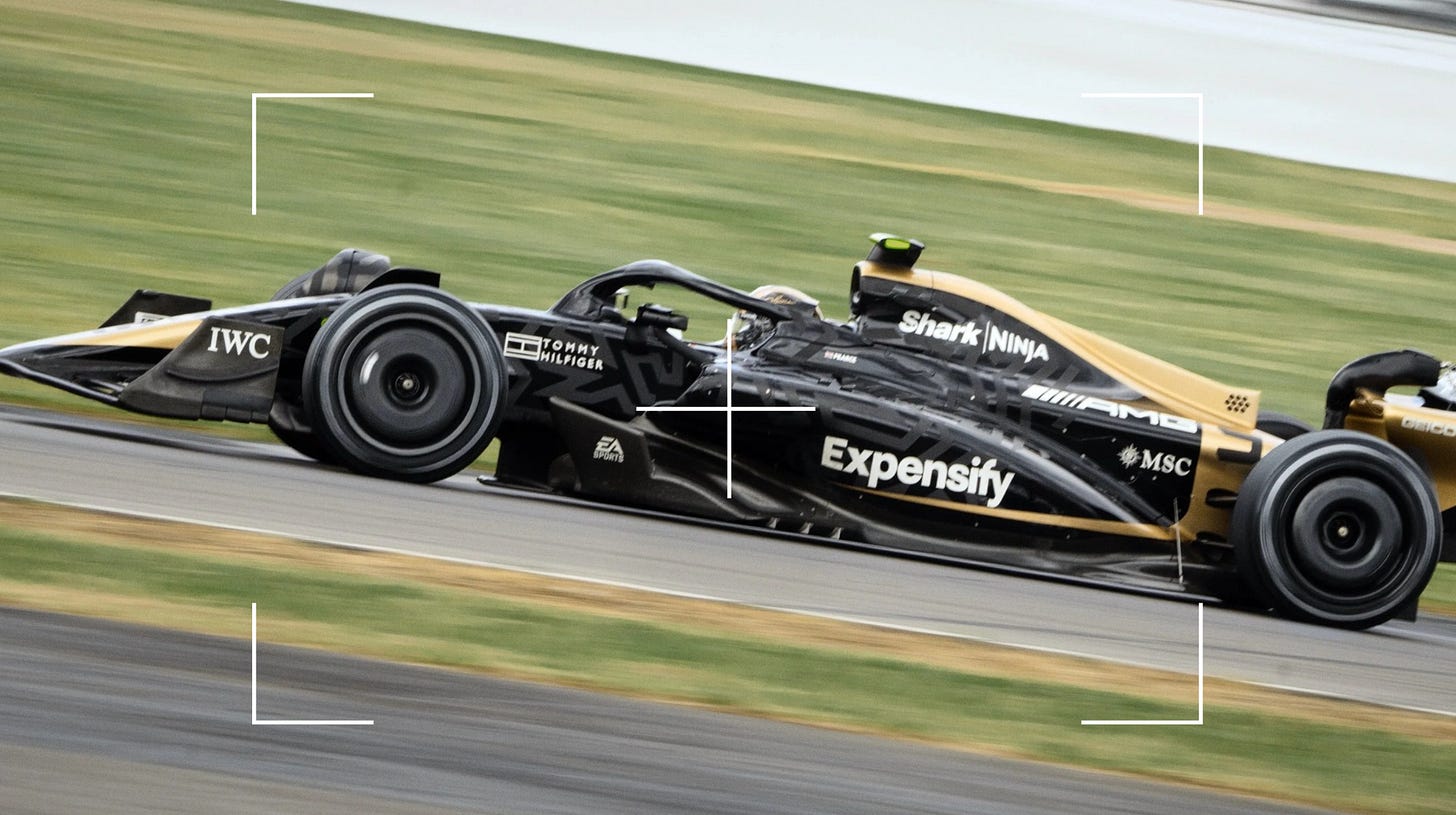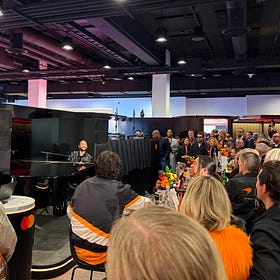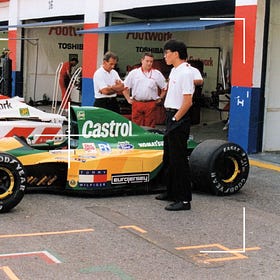Expensify won the F1 movie
and they didn’t even enter the race.
Thank you for being here. You are receiving this email because you subscribed to Idée Fixe, the newsletter for curious minds. I’m Toni Cowan-Brown, a tech and F1 commentator. I’m a former tech executive who has spent the past five years on the floor of way too many F1, FE, and WEC team garages, learning about the business, politics, and technology of motorsports.
⏳ Reading time: 10min
In a sport where brand logos cover everything from front wings to fuel tanks, team garages, team kits, helmets and race suits… one name managed to stand out more than any other during the highly anticipated Formula 1 movie debut: Expensify. The expense management platform didn’t sponsor a top-tier team. They didn’t back a driver. They didn’t even appear in the official paddock.
Instead, they sponsored APXGP - the fictional Formula 1 team featured in the film, co-produced by Lewis Hamilton and starring Brad Pitt. And yet, their logo had more uninterrupted, cinematic screen time than most real sponsors will get all year.
This wasn’t a sports sponsorship. It was brand storytelling disguised as sponsorship - and it might be one of the smartest marketing moves we’ve seen in Formula 1 this decade. Don’t worry, LEGO and WhatsApp, I see you.
The Modern sponsorship problem in F1
Sponsorship has always been central to the business of Formula 1. But today’s grid is oversaturated. It’s not a problem per se, nor is it a bad thing in itself, but the space has become incredibly noisy, and I don’t think many would disagree with this statement. Most teams now feature upwards of 35 to 50 sponsors; it used to be around half a dozen. McLaren had over 40 partners in 2024, and Williams listed 47. Sponsors range from luxury watch brands to regional delivery apps to B2B tech platforms.
Back in the 1980s and '90s, a car would often feature just five to ten logos, with one or two marquee partners defining the team’s identity: Marlboro at McLaren, Camel at Lotus, Rothmans at Williams, West at Mercedes. These were category-exclusive, often multi-year, global deals. The association was tight, bold, and memorable.
Now? With cluttered liveries and ever-expanding digital inventory brand recall has dropped, even as spending has gone up.
According to Nielsen Sports' 2023 report on sponsorship ROI in F1:
58% of F1 fans can’t recall more than two sponsors on a given team
Only 12% of viewers say sponsorship influences their purchasing decisions
Visibility in broadcast moments (crucial for ROI) is subject to factors sponsors can't control: crashes, poor race performance, lack of TV airtime
That’s the modern sponsor dilemma: massive spend, limited standout and hard to prove the ROI.
The Art/Science of Sports Sponsorship
Thank you for being here. You are receiving this email because you subscribed to Idée Fixe, the newsletter for curious minds. I’m Toni Cowan-Brown, a tech and F1 commentator. I’ve spent the past five years on the floor of way too many F1, FE, and WEC team garages, learning about the business, politics, and tech of motorsports. I hope you’ll stick around.
Expensify didn’t buy sponsorship; they bought the story
Expensify flipped the model. Instead of vying for a tiny logo slot on a sidepod - and hoping a driver finishes top five to get a few seconds of air time - they went where few other brands did: the narrative itself.
The movie, filmed in collaboration with F1, used real Grand Prix weekends, tracks, garages, and even race engineers as consultants to create authenticity. It had the realism of F1 Grand Prix with the permanence of cinema. That’s critical. Most F1 TV airtime is ephemeral - over in seconds, rarely seen again. But film creates immortal brand assets. Although it is worth saying that social media has popularised the highlight reels where key moments of race weekends and the races themselves are replayed over and over again - that is, until F1 send you a cease & desist.
With their logo embedded on the APXGP car, team gear, pit gantry, and more, Expensify became a fictional legacy sponsor. In a story watched globally, with replays, clips, memes, trailers, and YouTube reaction videos, their name is everywhere. As of today, the F1 movie “has amassed over $309 million worldwide at the box office and now finds itself within the top 100 highest-grossing films released by Warner Bros.” (that number has now surpassed $400 million as of July 18th).
This wasn’t just clever product placement - this was strategic brand architecture. In their own words, “Expensify isn’t just making expense reports or business travel easier. We’re showing the world how to think bigger, move faster, and execute smarter.”
The math: How much would this have cost in “real” F1?
Let’s do some back-of-the-envelope math. According to SportsPro Media, a mid-tier logo placement on an F1 car (say, nose cone or halo) costs between $5M–$10M per year. Top-tier brands like Oracle or Petronas may pay upwards of $30M+ annually at the low end, and can go up to $100 million per year for the most popular teams.
In contrast, product placement in major Hollywood films typically range from $250K to $2M, depending on screen time and integration. According to Forbes, the film brought in at least $40 million in brand sponsorships. And seeing as Expensify was the title sponsor of the fictional APXGP team, one can safely assume they paid upwards of $15M for this sponsorship.
Leener, a pioneer of brand integrations in movies for nearly 30 years, says he brought in more sponsor money for F1 than any film in his career—including Top Gun: Maverick, the two National Treasure pictures and several Transformer movies—by far. Forbes estimates Leener’s sponsorships for F1 have brought in at least $40 million. - Forbes
Plus, they didn’t have to share the spotlight as much as they would have if this were a non-fictional F1 car and team. In real F1, a brand competes visually with dozens of others on the same chassis. In the movie, Expensify was the main brand name consistently seen throughout the garage and race scenes. Tommy Hilfiger was also very present throughout the movie, but far more from a lifestyle perspective - think race suits, team kits and driver outfits.
And they avoided all the risks that come with sponsoring a real F1 team: poor performance, driver controversy, or being outshone by a rival sponsor.
What Does Tommy Hilfiger Know That We Don't?
Thank you for being here. You are receiving this email because you subscribed to Idée Fixe, the newsletter for curious minds. I’m Toni Cowan-Brown, a tech and F1 commentator. I’ve spent the past five years on the floor of way too many F1, FE, and WEC team garages, learning about the business, politics, and tech of motorsports. I hope you’ll stick around.
The rise of cinematic sponsorship (and why it works)
Expensify’s move signals a broader shift: from event-based to story-based marketing.
In a world where sports rights are fragmented across streaming platforms and viewers skip traditional ads, cinematic content becomes a high-trust, high-attention channel. You’re not interrupting the story - you are the story. We’ve seen hints of this in other sports: Nike in "Air" which told its own brand origin story, Under Armour in "The Blind Side" and "Any Given Sunday" where brands are embedded into athlete arcs and Heineken in Bond films where they are never just a product, always part of the plot. On that note, I wish Heineken brought some of this to F1 rather than just product placement.
What makes the F1 movie unique is that the series itself (and Liberty Media) co-produced the story - a first in modern sports. F1 gave the film its blessing, its race circuits, Mercedes helped them build F1-looking cars on top of F2 cars, and even allowed the production team to film during race weekends featuring the drivers, team principals and even key F1 personnel. Which means Expensify’s sponsorship came with real motorsport legitimacy.
This blurs the line between fiction and sport in a way that’s ripe for brand innovation. Expensify didn’t just luck into a good placement - they helped rewrite the brief as we know it.
In today’s environment, brands should ask:
Are we competing for eyeballs or engagement?
Is our sponsorship passive (logo exposure) or active (storytelling, cultural relevance)?
Can we create a fictional legacy more powerful than a real one?
Who’s our target audience and what/where are they watching?
The F1 movie won’t be a one-off. Expect more cinematic sports universes with branded teams, made-for-film sponsors, and fictional dynasties. Especially as leagues look to diversify revenue and brands look to escape the noise. Expensify though, might have been one of the first to try this, and they won.
What this signals: four predictions for the future of sports sponsorship
1. The rise of fictional teams in real sports worlds. What Drive to Survive did for docu-style storytelling, the F1 movie may do for fiction. And Expensify proved there’s real marketing value in imagined competition. Just as brands sponsor Marvel superheroes or FIFA video game teams, we’ll see more companies latch onto fictional franchises set inside real sports ecosystems, where they can control the narrative and avoid real-world messiness.
2. Branded storytelling will trump live visibility. Traditional sports sponsorship is increasingly unpredictable: your driver might crash out on Lap 1, your team might miss the playoffs, or your brand might be visually blocked in the frame. But in film, series, or even YouTube storytelling, brands get editorial control - and often eternal shelf life. You are also more likely to reach a new (sometimes unintended) audience through movies and films.
As a result, we’ll see more brands:
Shift dollars away from “live” sponsorships and toward media integrations
Invest in co-producing content, especially with athletes or teams they sponsor
Treat IP partnerships (like the F1 movie) as long-term brand assets, not one-offs
3. The sponsorship KPI shifts to cultural relevance. In the old model, sponsorship success = logo impressions + mentions + share of voice. But that’s not what modern audiences care about. What matters now is whether a brand can break through the noise and create a moment. Expensify didn’t just sponsor a car, they inserted themselves into the cultural conversation.
4. Legacy sponsors will have to compete with fictional ones. This is the real plot twist. If fictional teams like APXGP start getting more consistent screen time and emotional resonance than some real-world teams, sponsors may start asking themselves hard questions:. Why pay upwards of $30M for one logo in a crowded paddock when I could pay the same or a lot less for a lot more visibility, plus a narrative arc?
We may soon see:
“Hybrid” sponsor portfolios (some real, some fictional)
Teams responding with fewer logos but deeper, more cinematic activations
A new generation of fans who know the APXGP team better than Haas or Alpine
🔗 Apple is poised to win the rights to stream F1 racing in the US | NYT
Formula One is trending toward choosing Apple for its United States broadcasting rights from 2026, the technology company’s bid being in the $120-150 million per year range. Read here.
🔗 The weird rules of Wimbledon which just work | YouTube








I independently fell down this worm hole this morning. Interesting read on the subject. But the brand I would really like to open the books on in this regard is PEAK - as they are the sole and only brand to appear in the movie that do not have any current association with F1, but have had in the past. They - and their sister brand BlueDEF - sponsored Haas nosecones in 2018 and upped their involvement to the rear wing endplate in 2019. Ballpark figures for such a deal are $2-10MMUSD per season. The wrinkle here is that while PEAK does appear in the film, they do not appear in it as a sponsor of APXGP. They only appear as a sponsor of the fictional Chip Hart Racing in the Daytona sequence at the start of the film. The wrinkle within the wrinkle is that when Wright Motorsports - the outfit that supplied the cars that were liveried as Chip Hart Racing in the film - ran the 2024 Rolex 24 Hour at Daytona liveried as Chip Hart Racing, they ran the livery with PEAK as the door sponsor. They also ran minor sponsors that did not appear on the livery in the film. This car, and race footage from this race, was used in the film. Assuming this was part of the production, rather than promotional, costs; I wonder if there were two winners of the F1: The Movie production race. Expensify for sure in the big leagues and PEAK in the minors. Given their long and winding sponsorship in the film, I would have to think PEAK paid hundreds of thousands for it rather than millions.
such a great read